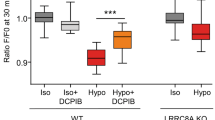Abstract.
Swelling-activated Cl− currents (I Cl,swell ) have been characterized in a mouse renal inner medullary collecting duct cell line (mIMCD-K2). Currents activated by exposing the cells to hypotonicity exhibited characteristic outward rectification and time- and voltage-dependent inactivation at positive potentials and showed an anion selectivity of I− > Br− > Cl− > Asp−. NPPB (100 μm) inhibited the current in a voltage independent manner, as did exposure to 10 μm tamoxifen and 500 μm niflumic acid (NFA). In contrast, DIDS (100 μm) blocked the current with a characteristic voltage dependency. These characteristics of I Cl,swell in mIMCD-K2 cells are essentially identical to those of heterologously expressed cardiac CLC-3.
A defining feature of CLC-3 is that activation of PKC by PDBu inhibits the conductance. In mIMCD-K2 cells preincubation with PDBu (100 nm) prevented the activation of I Cl,swell by hypotonicity. However, PDBu inhibition of I Cl,swell was reversed after PDBu withdrawal, but this was refractory to subsequent PDBu inhibition. Activation of either the cystic fibrosis transmembrane conductance regulator (CFTR) or Ca2+ activated Cl− conductance (CaCC), which are coexpressed in mIMCD-K2 cells prior to PDBu treatment, abolished the PDBu inhibition of I Cl,swell . Control of I Cl,swell by PKC therefore depends on the physiological status of the cell.
In intact mIMCD-K2 layers in Ussing chambers, forskolin stimulation of an inward short-circuit current (due to transepithelial Cl− secretion via apical CFTR) was inhibited by cell swelling upon hypotonic exposure at the basolateral surface. Activation of I Cl,swell is therefore capable of regulating transepithelial Cl− secretion and suggests that I Cl,swell is located at the basolateral membrane. PDBu exposure prior to or during hypotonic challenge was ineffective in reversing the swelling-activated inhibition of Cl− secretion, but tamoxifen (100 μm) abolished the hypotonic inhibition of forskolin-stimulated short-circuit current (I sc ).
RT-PCR analysis confirmed expression of mRNA for members of the CLC family, including both CLC-2 and 3, in the mIMCD-K2 cell line.
Similar content being viewed by others
Author information
Authors and Affiliations
Additional information
Received: 24 February 2000/Revised: 26 May 2000
Rights and permissions
About this article
Cite this article
Boese, S., Glanville, M., Gray, M. et al. The Swelling-Activated Anion Conductance in the Mouse Renal Inner Medullary Collecting Duct Cell Line mIMCD-K2. J. Membrane Biol. 177, 51–64 (2000). https://doi.org/10.1007/s002320001099
Issue Date:
DOI: https://doi.org/10.1007/s002320001099




